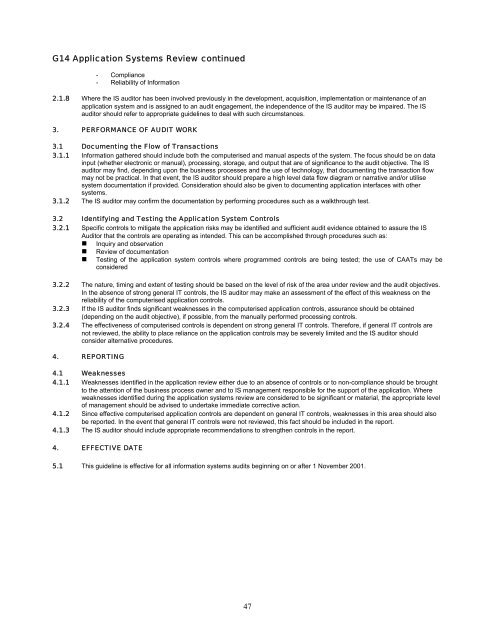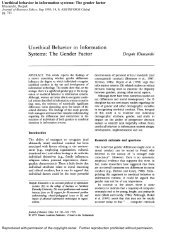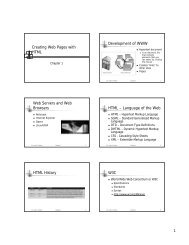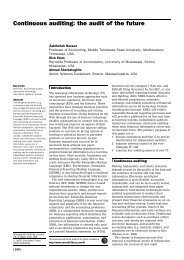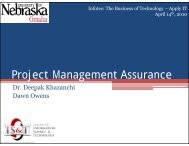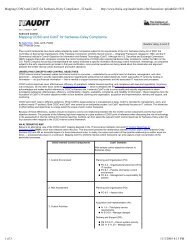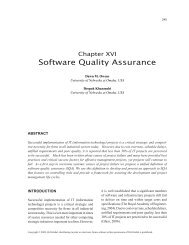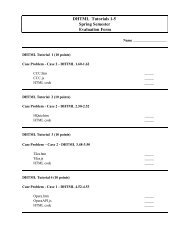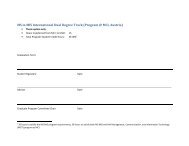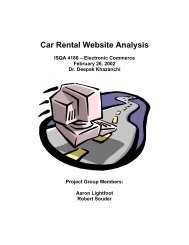IS Standards, Guidelines and Procedures for Auditing and Control ...
IS Standards, Guidelines and Procedures for Auditing and Control ...
IS Standards, Guidelines and Procedures for Auditing and Control ...
Create successful ePaper yourself
Turn your PDF publications into a flip-book with our unique Google optimized e-Paper software.
G14 Application Systems Review continued- Compliance- Reliability of In<strong>for</strong>mation2.1.8 Where the <strong>IS</strong> auditor has been involved previously in the development, acquisition, implementation or maintenance of anapplication system <strong>and</strong> is assigned to an audit engagement, the independence of the <strong>IS</strong> auditor may be impaired. The <strong>IS</strong>auditor should refer to appropriate guidelines to deal with such circumstances.3. PERFORMANCE OF AUDIT WORK3.1 Documenting the Flow of Transactions3.1.1 In<strong>for</strong>mation gathered should include both the computerised <strong>and</strong> manual aspects of the system. The focus should be on datainput (whether electronic or manual), processing, storage, <strong>and</strong> output that are of significance to the audit objective. The <strong>IS</strong>auditor may find, depending upon the business processes <strong>and</strong> the use of technology, that documenting the transaction flowmay not be practical. In that event, the <strong>IS</strong> auditor should prepare a high level data flow diagram or narrative <strong>and</strong>/or utilisesystem documentation if provided. Consideration should also be given to documenting application interfaces with othersystems.3.1.2 The <strong>IS</strong> auditor may confirm the documentation by per<strong>for</strong>ming procedures such as a walkthrough test.3.2 Identifying <strong>and</strong> Testing the Application System <strong>Control</strong>s3.2.1 Specific controls to mitigate the application risks may be identified <strong>and</strong> sufficient audit evidence obtained to assure the <strong>IS</strong>Auditor that the controls are operating as intended. This can be accomplished through procedures such as:• Inquiry <strong>and</strong> observation• Review of documentation• Testing of the application system controls where programmed controls are being tested; the use of CAATs may beconsidered3.2.2 The nature, timing <strong>and</strong> extent of testing should be based on the level of risk of the area under review <strong>and</strong> the audit objectives.In the absence of strong general IT controls, the <strong>IS</strong> auditor may make an assessment of the effect of this weakness on thereliability of the computerised application controls.3.2.3 If the <strong>IS</strong> auditor finds significant weaknesses in the computerised application controls, assurance should be obtained(depending on the audit objective), if possible, from the manually per<strong>for</strong>med processing controls.3.2.4 The effectiveness of computerised controls is dependent on strong general IT controls. There<strong>for</strong>e, if general IT controls arenot reviewed, the ability to place reliance on the application controls may be severely limited <strong>and</strong> the <strong>IS</strong> auditor shouldconsider alternative procedures.4. REPORTING4.1 Weaknesses4.1.1 Weaknesses identified in the application review either due to an absence of controls or to non-compliance should be broughtto the attention of the business process owner <strong>and</strong> to <strong>IS</strong> management responsible <strong>for</strong> the support of the application. Whereweaknesses identified during the application systems review are considered to be significant or material, the appropriate levelof management should be advised to undertake immediate corrective action.4.1.2 Since effective computerised application controls are dependent on general IT controls, weaknesses in this area should alsobe reported. In the event that general IT controls were not reviewed, this fact should be included in the report.4.1.3 The <strong>IS</strong> auditor should include appropriate recommendations to strengthen controls in the report.4. EFFECTIVE DATE5.1 This guideline is effective <strong>for</strong> all in<strong>for</strong>mation systems audits beginning on or after 1 November 2001.47


